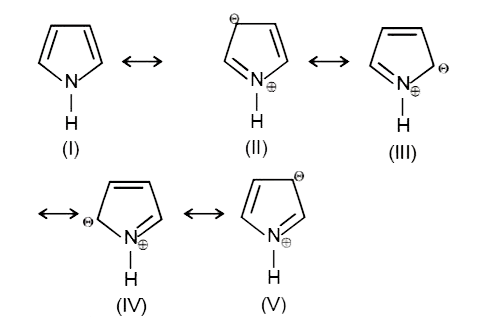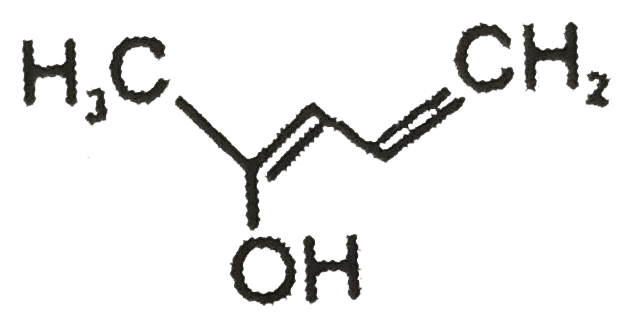Write resonating structures for CH2=CHCHO. Indicate relative stability of the contributing structures :
To find the resonating structures for the compound CH2=CHCHO (acrolein), we will follow these steps:
Step 1: Identify the structure of the molecule
The given compound CH2=CHCHO consists of a double bond between the first two carbon atoms and a carbonyl group (C=O) at the end. The structure can be represented as follows:
HH C∣∣∣∣∣∣CHO∣∣∣∣∣∣H
Step 2: Draw the first resonating structure
In the first resonating structure, we maintain the double bond between the first two carbon atoms and the carbonyl group intact. This structure has no charges and is stable:
HH C∣∣CHO
Step 3: Draw the second resonating structure
In the second resonating structure, we can move the pi electrons from the C=C bond to the carbonyl oxygen. This results in a positive charge on the first carbon and a negative charge on the oxygen:
HH C+∣∣CHO−
Step 4: Draw the third resonating structure
In the third resonating structure, we can also move the pi electrons from the carbonyl (C=O) bond to the carbon atom adjacent to it. This results in a positive charge on the carbon adjacent to the carbonyl and a negative charge on the oxygen:
HH C∣∣C+HO−
Step 5: Analyze the stability of the resonating structures
1. First Structure: This structure has no charges, and all atoms have complete octets. It is the most stable structure.
2. Second Structure: This structure has a negative charge on the oxygen (which is electronegative) and a positive charge on the carbon. This structure is relatively stable due to the negative charge being on the more electronegative atom.
3. Third Structure: This structure has a positive charge on the oxygen, which is less stable because it places a positive charge on an electronegative atom. Therefore, it is the least stable of the three structures.
Conclusion
The order of stability of the resonating structures is:
1. First Structure (most stable)
2. Second Structure
3. Third Structure (least stable)
The given compound CH2=CHCHO consists of a double bond between the first two carbon atoms and a carbonyl group (C=O) at the end. The structure can be represented as follows:
In the first resonating structure, we maintain the double bond between the first two carbon atoms and the carbonyl group intact. This structure has no charges and is stable:
In the second resonating structure, we can move the pi electrons from the C=C bond to the carbonyl oxygen. This results in a positive charge on the first carbon and a negative charge on the oxygen:
In the third resonating structure, we can also move the pi electrons from the carbonyl (C=O) bond to the carbon atom adjacent to it. This results in a positive charge on the carbon adjacent to the carbonyl and a negative charge on the oxygen:
1. First Structure: This structure has no charges, and all atoms have complete octets. It is the most stable structure.
2. Second Structure: This structure has a negative charge on the oxygen (which is electronegative) and a positive charge on the carbon. This structure is relatively stable due to the negative charge being on the more electronegative atom.
3. Third Structure: This structure has a positive charge on the oxygen, which is less stable because it places a positive charge on an electronegative atom. Therefore, it is the least stable of the three structures.
The order of stability of the resonating structures is:
1. First Structure (most stable)
2. Second Structure
3. Third Structure (least stable)
Topper's Solved these Questions
- ORGANIC CHEMISTRY: BASIC PRINCIPLES AND TECHNIQUESBOOK - MODERN PUBLICATIONCHAPTER - ORGANIC CHEMISTRY: BASIC PRINCIPLES AND TECHNIQUESEXERCISE - (PRACTICE PROBLEMS)
31 Videos
- ORGANIC CHEMISTRY: BASIC PRINCIPLES AND TECHNIQUESBOOK - MODERN PUBLICATIONCHAPTER - ORGANIC CHEMISTRY: BASIC PRINCIPLES AND TECHNIQUESEXERCISE - (CONCEPTUAL QUESTIONS 1 )
29 Videos
- MOCK TEST-2BOOK - MODERN PUBLICATIONCHAPTER - MOCK TEST-2EXERCISE - SECTION D
1 Videos
- REDOX REACTIONS BOOK - MODERN PUBLICATIONCHAPTER - REDOX REACTIONS EXERCISE - COMPETITION FILE (Objective Questions) (C. MULTIPLE CHOICE QUESTIONS)
9 Videos
Similar Questions
Write resonating structures for CH2=CHCHO. Indicate relative stability of the contributing structures :
View SolutionWhich the resonance structure of the following species :
(i) :−CH2−C≡N:
(ii) CH3CH=CH−+CH−CH3
(iii) +CH2−CH=CH−−CH2
(iv) CH3−:O:∣∣C−−C..H2
(B) Write resonance structure for the intermediate carbocation in the aromatic chlorination of benzene.
(C) Write the main resonance structure of the conjugate base of a 1, 3-diketone.
(D) Write the resonance structure of CH2=CH−CHO. Indicate relative stability of the contributing structures.
View Solution
Knowledge Check
Compare relative stability of the following resonating structure.
 Ap>q>rBq>p>rCq>r>pDp>r>q
Ap>q>rBq>p>rCq>r>pDp>r>qWrite the stability order of Resonating Structures:
 A(III=IV)>(II=V)>IBI>(II=V)>(III)=IV)CI>(III=IV)>(II=V)D(II=V)>(III=V)>I
A(III=IV)>(II=V)>IBI>(II=V)>(III)=IV)CI>(III=IV)>(II=V)D(II=V)>(III=V)>ICompare relative stability of the following resonating strucrtrue.
 A(i)>(ii)>(iii)B(ii)>(i)>(iii)C(i)>(iii)>(ii)D(ii)>(III)>(i)
A(i)>(ii)>(iii)B(ii)>(i)>(iii)C(i)>(iii)>(ii)D(ii)>(III)>(i)
Write resonating structures of CH3COO− ion.
View SolutionWrite the resonance structure of CO2 .
View SolutionWrite the resonance structures of (1)CH3COOӨ and (2)CH2=CH−CHO. Indicate the relative stability of the contributing structures.
View SolutionWrite resonating structure of the compound

View SolutionThe correct stability order of given resonating structures

View Solution
